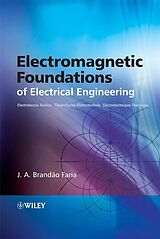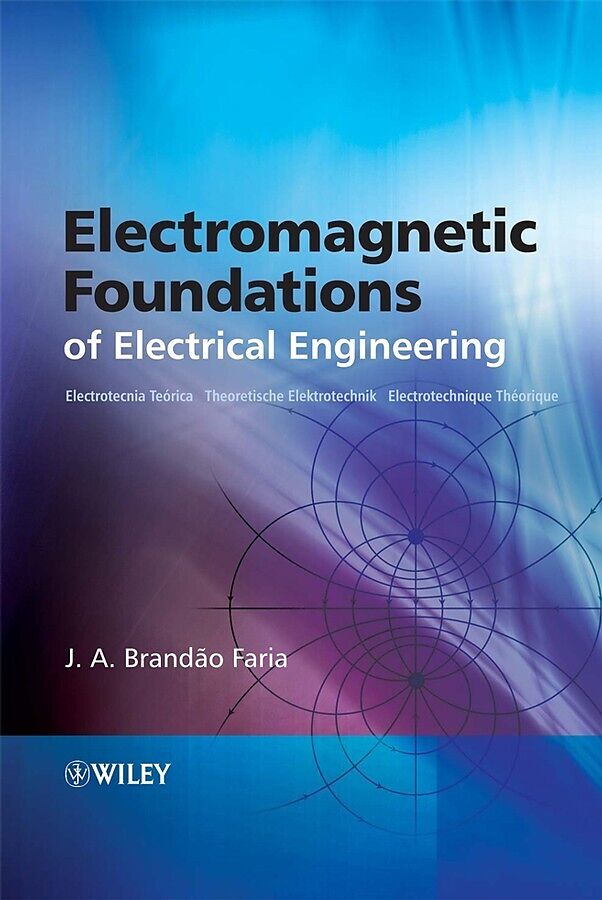Electromagnetic Foundations of Electrical Engineering
Format:
E-Book (pdf)
EAN:
9780470697481
Untertitel:
Englisch
Genre:
Elektronik, Elektrotechnik, Nachrichtentechnik
Autor:
J. A. Brandão Faria
Herausgeber:
Wiley
Anzahl Seiten:
420
Erscheinungsdatum:
15.09.2008
ISBN:
978-0-470-69748-1
The applications of electromagnetic phenomena within electrical
engineering have been evolving and progressing at a fast pace. In
contrast, the underlying principles have been stable for a long
time and are not expected to undergo any changes. It is these
electromagnetic field fundamentals that are the subject of
discussion in this book with an emphasis on basic principles,
concepts and governing laws that apply across the electrical
engineering discipline.
Electromagnetic Foundations of Electrical Engineering
begins with an explanation of Maxwell's equations, from which
the fundamental laws and principles governing the static and
time-varying electric and magnetic fields are derived. Results for
both slowly- and rapidly-varying electromagnetic field problems are
discussed in detail.
Key aspects:
* Offers a project portfolio, with detailed solutions included on
the companion website, which draws together aspects from various
chapters so as to ensure comprehensive understanding of the
fundamentals.
* Provides end-of-chapter homework problems with a focus on
engineering applications.
* Progresses chapter by chapter to increasingly more challenging
topics, allowing the reader to grasp the more simple phenomena and
build upon these foundations.
* Enables the reader to attain a level of competence to
subsequently progress to more advanced topics such as electrical
machines, power system analysis, electromagnetic compatibility,
microwaves and radiation.
This book is aimed at electrical engineering students and
faculty staff in sub-disciplines as diverse as power and energy
systems, circuit theory and telecommunications. It will also appeal
to existing electrical engineering professionals with a need for a
refresher course in electromagnetic foundations.
Autorentext
J. A. Brandão Faria received his PhD degree and aggregate title in electrical engineering from the Instituto Superior Técnico of the Technical University of Lisbon, where, since 1994, he has been a Full Professor of Electrical Engineering teaching undergraduate and graduate courses in electromagnetics. His teaching activities also include lecturing courses at the Portuguese Air Force Academy.
Professor Brandão Faria was a senior scientist with the former Centro de Electrotecnia Teórica e Medidas Eléctricas where he served as President from 1994 until 2000. Since 2008, he has been at the recently created CIEEE (Center for Innovation in Electrical Engineering and Energy).
Professor Brandão Faria was the recipient of two Honorable Mentions awarded in 1994 and 2007 by the Portuguese State Department of Science and Technology, and by the Technical University of Lisbon, respectively. His areas of interest include electromagnetic field problems, power lines, and wave propagation phenomena in multiconductor transmission lines. He is the author of two books on electrical engineering subjects, namely Optica and Multiconductor Transmission-Line Structures, and has published over 100 technical papers.
Professor Brandão Faria is a member of the Editorial Board of the European Transactions on Electrical Power (John Wiley & Sons, Ltd) and a senior member of the IEEE.
Klappentext
The applications of electromagnetic phenomena within electrical engineering have been evolving and progressing at a fast pace. In contrast, the underlying principles have been stable for a long time and are not expected to undergo any changes. It is these electromagnetic field fundamentals that are the subject of discussion in this book with an emphasis on basic principles, concepts and governing laws that apply across the electrical engineering discipline. Electromagnetic Foundations of Electrical Engineering begins with an explanation of Maxwell's equations, from which the fundamental laws and principles governing the static and time-varying electric and magnetic fields are derived. Results for both slowly- and rapidly-varying electromagnetic field problems are discussed in detail. Key aspects: Offers a project portfolio, with detailed solutions included on the companion website, which draws together aspects from various chapters so as to ensure comprehensive understanding of the fundamentals. Provides end-of-chapter homework problems with a focus on engineering applications. Progresses chapter by chapter to increasingly more challenging topics, allowing the reader to grasp the more simple phenomena and build upon these foundations. Enables the reader to attain a level of competence to subsequently progress to more advanced topics such as electrical machines, power system analysis, electromagnetic compatibility, microwaves and radiation. This book is aimed at electrical engineering students and faculty staff in sub-disciplines as diverse as power and energy systems, circuit theory and telecommunications. It will also appeal to existing electrical engineering professionals with a need for a refresher course in electromagnetic foundations.
Inhalt
PREFACE. To the Electrical Engineer Practitioner. To the Student. To the Instructor. ACKNOWLEDGEMENTS. PROJECT PORTFOLIO. Analysis of a power delivery system. Cylindrical type transmission lines. DC current transducer. Determination of the conductivity of a circular conducting disk. Directional coupler analysis. Ill-defined grounding problems. Induction machine analysis. Line matching technique using an exponential transmission-line section. Linear variable differential transformer. Magnetic actuator and sensor device. Overhead-line protection by ground-wires. Power line carrier communication. Pseudo-balanced three-phase lines. Screened high-voltage three-phase installation. Shielded three-phase cable analysis. Three-route microwave splitter. Transmission-line system with balun transformer for even to odd-mode conversion. Transmission-line system with transformer-stage matching. Two-way loudspeaker analysis. Variable reluctance transformer. PART I: A BRIEF OVERVIEW. INTRODUCTION. CHAPTER 1: BASIC FIELD VECTORS. 1.1: The Electric and Magnetic Field Vectors. 1.2: Constitutive Relations. 1.3: Units and Notation. 1.4: Fundamental Concepts of Voltage and Current Intensity. PART II: STATIONARY FIELD PHENOMENA. INTRODUCTION. CHAPTER 2: ELECTROSTATICS. 2.1 Fundamental Equations. 2.2 Gradient Electric Field, Electric Potential, Voltage, Kirchhoff's Voltage Law. 2.3 Electric Charge, Electric Displacement Vector. 2.4 Dielectric Media, Permittivity, Polarization, Dielectric Strength. 2.5 Conductors in Electrostatic Equilibrium. 2.6 Application Example (Filament of charge). 2.7 Capacitor, Capacitance, Electric Energy. 2.8 Application Example (Two-wire transmission line). 2.9 Multiple Conductor Systems. 2.10 Application Example (Electric coupling in printed circuit boards). 2.11 Electric Forces and Torques. 2.12 Homework Proposed Problems. CHAPTER 3: STATIONARY CURRENTS. 3.1 Fundamental Equations. 3.2 Conductivity, Current Density, Electric Circuits. 3.3 Current Intensity, Kirchhoff's Current Law. 3.4 Resistor, Conductance, Resistance, Ohm's Law. 3.5 Application Example (The potentiometer). 3.6 Application Example (The Wheatstone bridge). 3.7 Joule Losses, Generator Applied Field. 3.8 Generator Electromotive Force, Power Balance. 3.9 Homework Proposed Problems.

Leider konnten wir für diesen Artikel keine Preise ermitteln ...
billigbuch.ch sucht jetzt für Sie die besten Angebote ...
Die aktuellen Verkaufspreise von 3 Onlineshops werden in Realtime abgefragt.
Sie können das gewünschte Produkt anschliessend direkt beim Anbieter Ihrer Wahl bestellen.
Loading...
Die aktuellen Verkaufspreise von 3 Onlineshops werden in Realtime abgefragt.
Sie können das gewünschte Produkt anschliessend direkt beim Anbieter Ihrer Wahl bestellen.
| # | Onlineshop | Preis CHF | Versand CHF | Total CHF | ||
|---|---|---|---|---|---|---|
| 1 | Seller | 0.00 | 0.00 | 0.00 |
